DNA methylation and hydroxymethylation are important epigenetic modifications for gene expression regulation. DNA methylation typically represses gene transcription. Hydroxymethylation, on the contrary, activates gene expression or prompts DNA demethylation.
5-Hydroxymethylcytosine (5hmC) is converted from 5-methylcytosine (5mC) by a group of enzymes termed ten-eleven translocation (TET) family dioxygenases. The gold-standard bisulfite conversion technologies to study DNA methylation do not distinguish between 5mC and 5hmC. However, new approaches to mapping 5hmC genomewide have advanced rapidly, although it is unclear how the different methods compare in accurately calling 5hmC.
CD Genomics can provide two 5hmC genome-wide detection approaches:
1. Whole-genome bisulfite/oxidative bisulfite sequencing (WGBS/OxBS-seq)
2. Antibody-based immunoprecipitation and sequencing of hydroxymethylated DNA (hMeDIP-seq).
The Introduction of hMeDIP-seq
5-hydroxymethylcytosine (5hmC) is a recently discovered modified base, generated by the oxidation of 5mC through enzymes of the TET family. This modification not only reduces the methylated DNA binding domain (MBD) interaction with methylated DNA, potentially impacting transcriptional regulation and gene expression, but also plays a role in the process of DNA demethylation.
While the precise function of 5-hmC has yet to be determined, it has been postulated that it could represent a pathway to demethylated DNA, as 5-hydroxymethylcytosine is repaired as mismatched DNA and replaced with unmethylated cytosine. Hydroxymethylation is essential for the regulation of embryonic development, stem cell pluripotency, genomic imprinting, X-chromosome inactivation, and spermatogenesis. Abnormal hydroxymethylation of DNA often causes a variety of diseases, such as cancer and male infertility. Moreover, these abnormal DNA modifications may be inherited by offspring via the gametes, and the diseases these modifications cause could also be passed to future generations.
Hydroxymethylated DNA immunoprecipitation (hMeDIP) is an immunocapture technique in which a 5-hydroxymethylcytidine antibody is used to recognize DNA fragments containing 5-hmc, and can effectively enrich hydroxymethylated DNA fragments in genome-wide assays. This selectivity is important as most common approaches to analyze DNA methylation, such as enzymatic approaches and bisulfite conversion, are unable to distinguish between 5-hmC and 5-mC.
Hydroxymethylated DNA Immunoprecipitation Sequencing (hMeDIP-Seq) is a method that utilizes 5hmC-specific antibodies to enrich and sequence hydroxymethylated regions at a genome-wide scale. It finds broad applications in investigating the relationship between hydroxymethylation and diseases, as well as in studying hydroxymethylation in embryonic development. Compared to oxBS-seq, hMeDIP offers a cost-effective approach for profiling hydroxymethylation.
Library construction, high-throughput sequencing and bioinformatic analysis of these hydroxymethylated DNA fragments can provide us maps of genome-wide hydroxymethylation under particular physiological or pathological conditions.
Advantages of hMeDIP-seq
- Provide a thorough analysis of hydroxymethylation in the genome.
- Differentiates between hydroxymethylation and methylation, preventing false positives common in traditional methylation analyses.
- Suitable for small sample sizes and samples with low hydroxymethylation levels.
- High specificity: Targets genomic areas with methylation modifications.
- Cost-effective: Significantly reduces sequencing data volume, leading to lower sequencing costs.
Applications of hMeDIP-seq
- Biomedical Research: Investigating the role of hydroxymethylation in the development and progression of diseases such as cancer and neurological disorders.
- Developmental Biology: Elucidating the epigenetic regulatory mechanisms of hydroxymethylation in embryonic development and organ formation.
- Environmental Exposure Studies: Exploring the impact of environmental factors on hydroxymethylation patterns to unveil their influence on the genomic stability.
hMeDIP-seq Workflow
Genomic DNA was sonicated to produce DNA fragments, size selection of 300 to 500 bp fragments. Illumina barcode adapters were ligated before hMeDIP. Approximately 4 mg of adaptor-ligated gDNA were pooled together in one tube. IP buffer was used to denature and dilute the mixed DNA. The denatured DNA was incubated with anti-5mC antibody. The antibody–DNA complexes were captured and purified by beads, and the hydroxymethylated fragments were amplified using adaptor-specific primers and quantified on an Agilent 2100 Bioanalyser before cluster generation and sequencing on illumina platform according to the manufacturer's protocols.

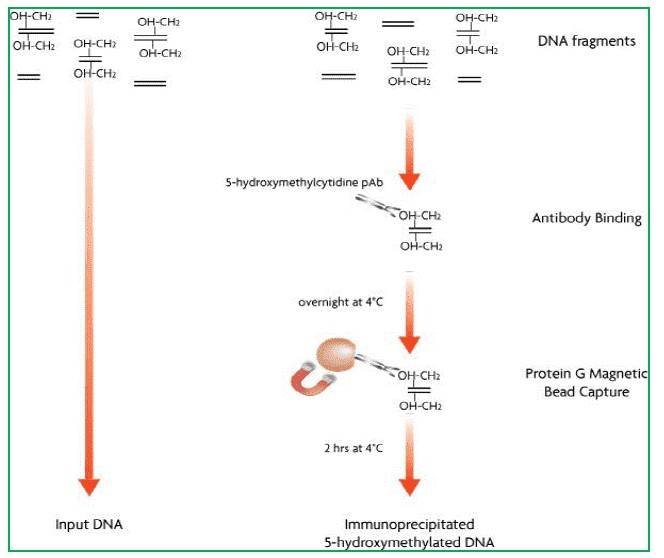
Service Specifications
Sample Requirements
|
|
Click |
Sequencing Strategy
|
| Bioinformatics Analysis We provide multiple customized bioinformatics analyses:
|
Analysis Pipeline
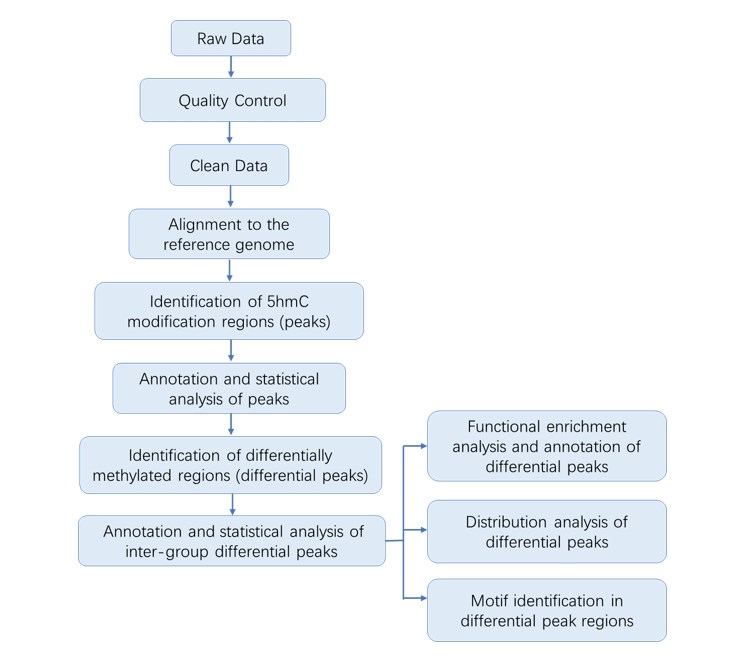
Deliverables
- The original sequencing data
- Experimental results
- Data analysis report
- Details in hMeDIP-seq for your writing (customization)
Discover epigenetic modifications with CD Genomics' hMeDIP-seq service. We offer advanced technologies for high-throughput immunoprecipitation and sequencing of hydroxymethylated DNA, coupled with comprehensive bioinformatics analysis to uncover critical epigenetic insights across genomes. Contact us today to enhance your research with precise epigenetic data.
References
- Ding P, Guangzhe G, Yanqing G, et al. Vitamin C increases 5-hydroxymethylcytosine level and inhibits the growth of bladder cancer. Clinical Epigenetics, 2018, 10(1):94.
- Li G, Qian H. Hypo-hydroxymethylation of rRNA genes in the precocious Eriocheir sinensis testes revealed using hMeDIP-seq. Scientific Reports, 2017, 7(1):11237.
Partial results are shown below:
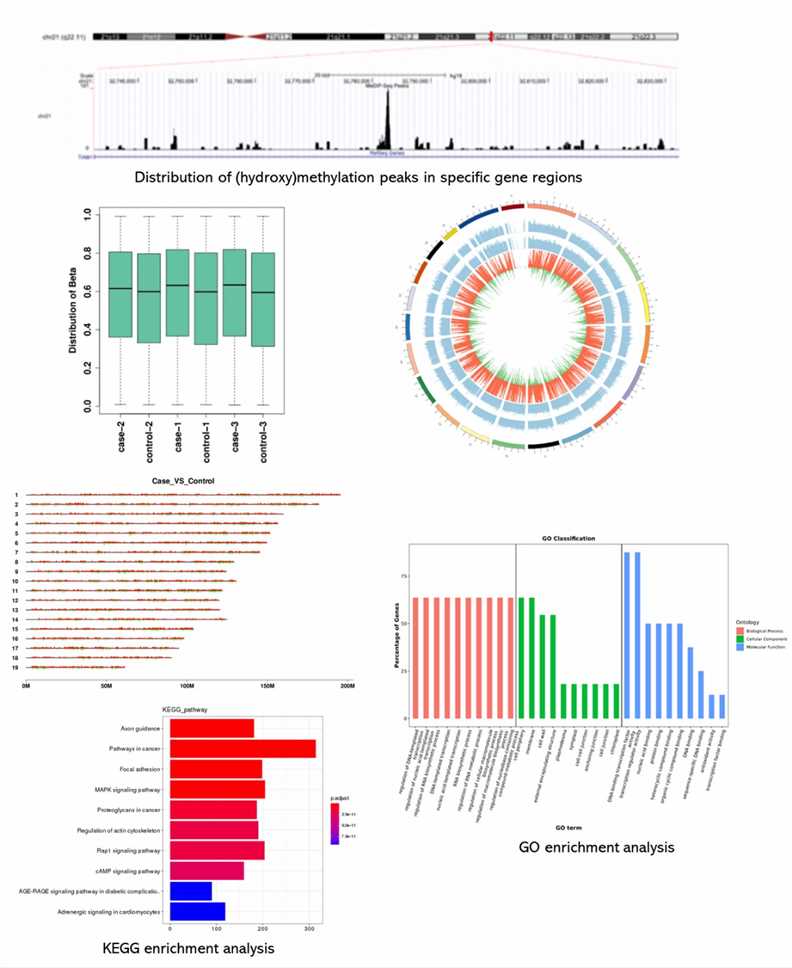
1. How does hMeDIP-seq work?
Immunoprecipitation: Antibodies specific to 5hmC selectively pull down hydroxymethylated DNA fragments from a sample.
Sequencing: The enriched DNA fragments are then sequenced using next-generation sequencing technologies to obtain a high-resolution map of hydroxymethylation patterns across the genome.
2. What are the challenges of hMeDIP-seq?
Challenges include the need for high-quality antibodies specific to 5hmC, data analysis complexities due to sequence alignment and peak calling, and distinguishing 5hmC from 5mC, which may require integrative approaches with other sequencing techniques.
3. How can hMeDIP-seq contribute to biomedical research?
It can identify hydroxymethylation patterns associated with disease progression, biomarker discovery, and potential therapeutic targets. It also aids in understanding epigenetic regulation in normal physiological processes and environmental responses.
Microbiota regulates the TET1-mediated DNA hydroxymethylation program in innate lymphoid cell differentiation
Journal: Nature Communications
Impact factor: 16.6
Published: 05 June 2024
Background
Innate lymphoid cells (ILCs) play pivotal roles in mucosal immunity, influencing pathogen resistance, tissue repair, and metabolic regulation. Their differentiation hinges on lineage-specific transcription factors and cytokines, while epigenetic factors like DNA methylation and 5hmC modulate gene expression patterns critical for ILC development. The microbiota's influence on ILC differentiation underscores its role in shaping immune responses and maintaining intestinal homeostasis across different life stages. Authors employed ChIP-qPCR, MeDIP-seq, and hMeDIP-seq methods to further elucidate epigenetic regulation in ILC development and response to microbial signals.
Materials & Methods
Sample Preparation
- WT C57BL/6J mice
- Intestines tissues
- DNA extraction
- Total RNA extraction
Sequencing
- ChIP-qPCR
- MeDIP-seq
- hMeDIP-seq
- 16S rRNA sequencing
- RNA-seq
- Alpha diversity analysis
- Differential gene expression analysis
- Peak annotation
- Metabolomics analysis
Results
Genome-wide analysis of 5hmC and 5mC in ILC and ILCP subsets revealed dynamic patterns crucial for understanding their differentiation. Both ILC subsets and their precursors (ILCPs) showed reduced 5hmC and 5mC levels at transcription start and end sites, as well as in promoter regions. ILCPs exhibited higher levels of 5hmC and 5mC, suggesting active DNA demethylation during differentiation. Significant changes in DNA hydroxymethylation and methylation were observed in promoter regions, particularly affecting genes related to metabolism and immune function. These findings underscore the role of epigenetic regulation in modulating gene expression during ILC differentiation and immune responses.
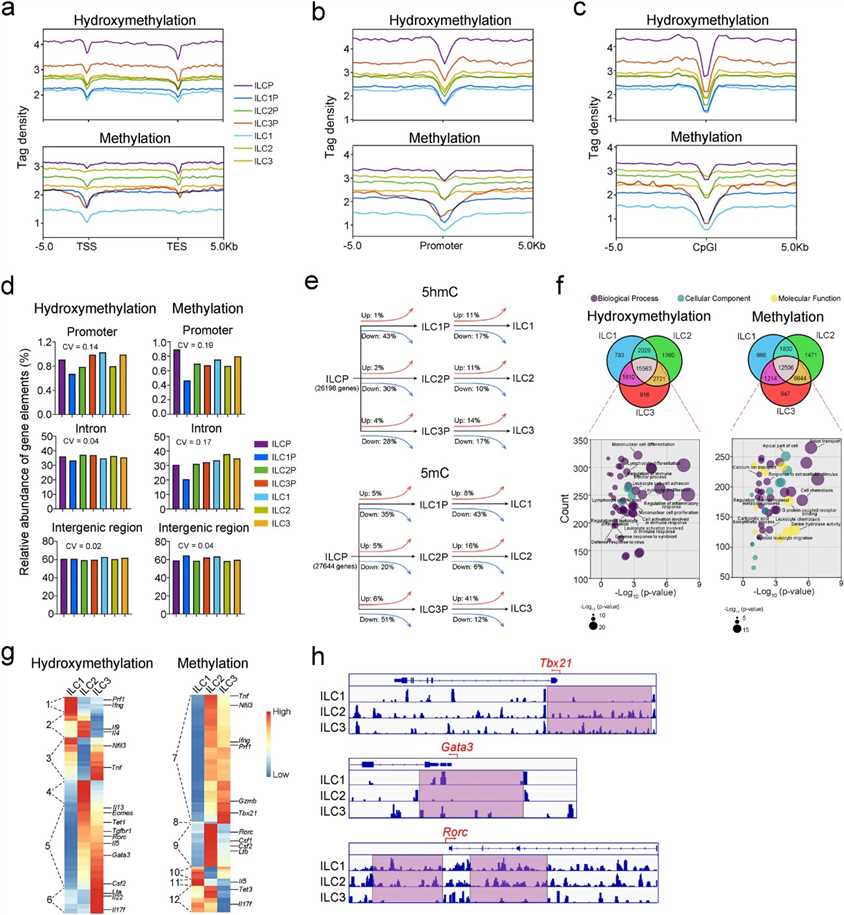 Fig. 1: Genome-wide distribution of 5hmC and 5mC in ILCs and ILC precursors.
Fig. 1: Genome-wide distribution of 5hmC and 5mC in ILCs and ILC precursors.
TET1 promotes Tgfbr1 hydroxymethylation, inhibiting ILC1 differentiation. Depletion of Tet1 reduces 5hmC levels in ILCPs, altering gene expression. TET1 binds Tgfbr1 regions, affecting its methylation and expression. Inhibition of TGF-β signaling reverses ILC1 suppression in Tet1-deficient ILCPs, showing TET1's role in regulating ILC differentiation via TGF-β signaling.
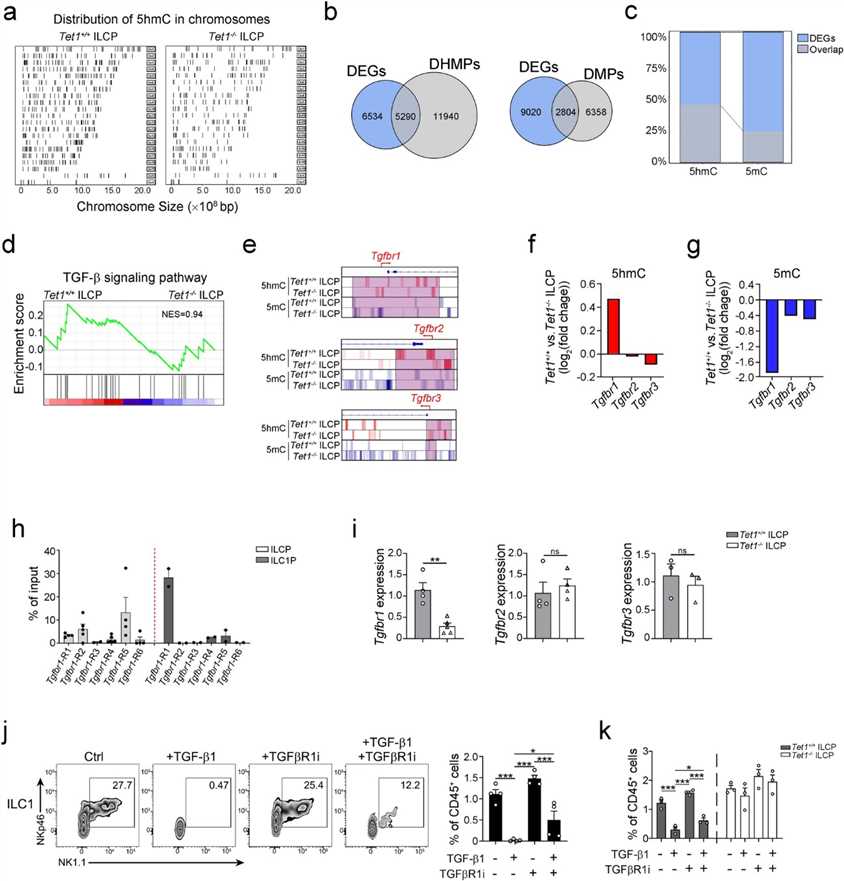 Fig. 2: TET1 contributes to the hydroxymethylation of the Tgfbr1 gene and suppresses ILC1 differentiation.
Fig. 2: TET1 contributes to the hydroxymethylation of the Tgfbr1 gene and suppresses ILC1 differentiation.
Intestinal microbiota suppresses DNA hydroxymethylation in ILCPs, promoting ILC1 differentiation. Germ-free conditions reduce ILC1 populations, restored by microbiota re-colonization. Microbiota depletion increases 5hmC in ILCPs, affecting gene regions. Re-introduction alters 5hmC and 5mC in ILCP promoters, reducing Tet1 and Tgfbr1 methylation, influencing ILC1 via TGF-β1 signaling.
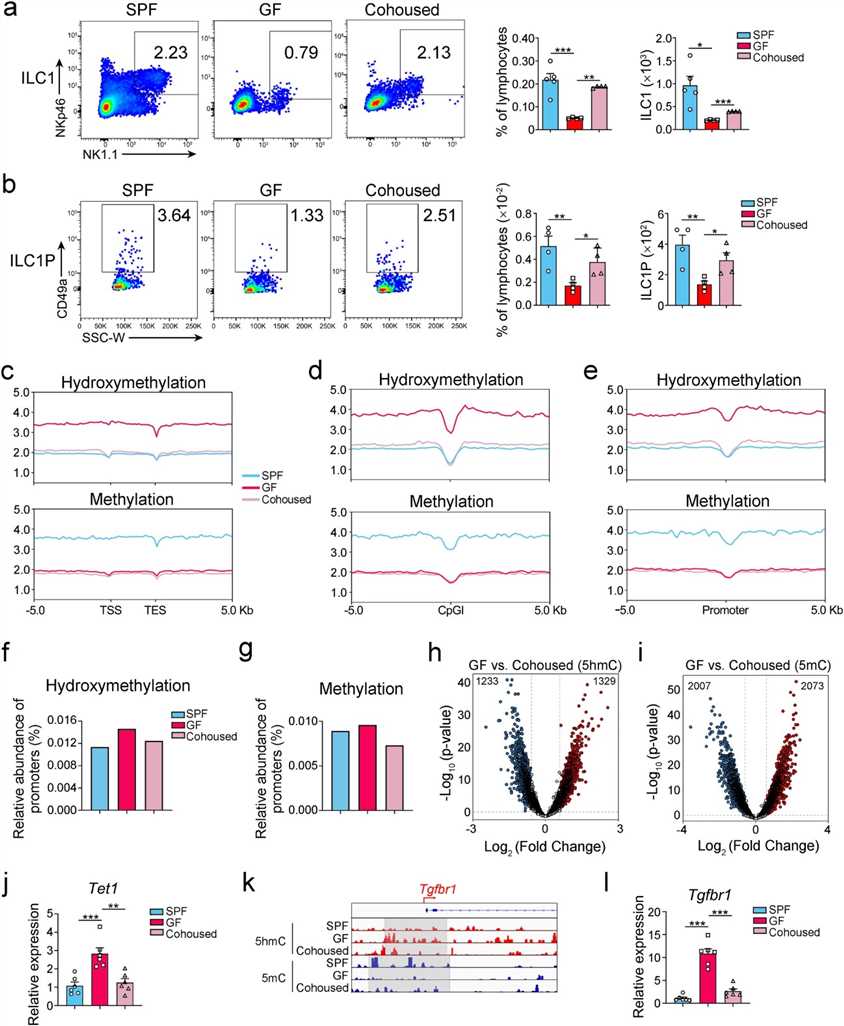 Fig. 3: Gut microbiota modulates the DNA hydroxymethylation program from ILCPs to ILC1s.
Fig. 3: Gut microbiota modulates the DNA hydroxymethylation program from ILCPs to ILC1s.
Conclusion
ILC precursors (ILCPs) differentiate into various functional ILC subsets driven by complex epigenetic changes. TET1 inhibits ILC1 differentiation by suppressing TGF-β signaling, with its expression regulated by gut microbiota and cholic acid levels. This study highlights microbiota-mediated epigenetic control of ILCs, crucial for maintaining intestinal homeostasis in adult mice.
Reference
- Zhang, X., Gao, X., Liu, Z. et al. Microbiota regulates the TET1-mediated DNA hydroxymethylation program in innate lymphoid cell differentiation. Nat Commun, 2024, 15, 4792.
Here are some publications that have been successfully published using our services or other related services:
Restriction endonuclease cleavage of phage DNA enables resuscitation from Cas13-induced bacterial dormancy
Journal: Nature microbiology
Year: 2023
IL-4 drives exhaustion of CD8+ CART cells
Journal: Nature Communications
Year: 2024
High-Fat Diets Fed during Pregnancy Cause Changes to Pancreatic Tissue DNA Methylation and Protein Expression in the Offspring: A Multi-Omics Approach
Journal: International Journal of Molecular Sciences
Year: 2024
KMT2A associates with PHF5A-PHF14-HMG20A-RAI1 subcomplex in pancreatic cancer stem cells and epigenetically regulates their characteristics
Journal: Nature communications
Year: 2023
Cancer-associated DNA hypermethylation of Polycomb targets requires DNMT3A dual recognition of histone H2AK119 ubiquitination and the nucleosome acidic patch
Journal: Science Advances
Year: 2024
Genomic imprinting-like monoallelic paternal expression determines sex of channel catfish
Journal: Science Advances
Year: 2022
See more articles published by our clients.


 Sample Submission Guidelines
Sample Submission Guidelines
